THEATER OF THE WORLD AND THE BRIDGE
GALLERY 208
Huang Yong Ping’s two-part architectural installation is an arena of life. The Bridge, an arching, serpentine cage, contains snakes and turtles crawling among scattered Chinese bronze sculptures of mythological animal forms. Beneath it, live reptiles dart among hundreds of insects inside the tortoise-like structure called Theater of the World.
Huang’s design refers to the panopticon, an eighteenth-century prison concept by English philosopher Jeremy Bentham that enabled constant surveillance from a single central point, and that was later taken up by Michel Foucault in his 1975 book Discipline and Punish as a metaphor for how modern societies control their subjects. Huang’s installation is also inspired by the mythological creature and Daoist deity Xuanwu, a hybrid animal with the head and tail of a snake and the body of a tortoise—symbolically the most potent pair in Chinese cosmology, whose union, according to some tales, created the universe. Drawing on Daoist cosmology and magic, Foucault’s theories on modernism as prison, and debates on the ills of globalization, Huang wrote:
Is the Theater of the World an insect zoo? […] A space for observing the activity of “insects”? An architectural form as a closed system? A cross between a panopticon and the shamanistic practice of keeping insects? A metaphor for the conflict among different peoples and cultures? Or, rather, a modern representation of the ancient Chinese character gu (chaos)?


